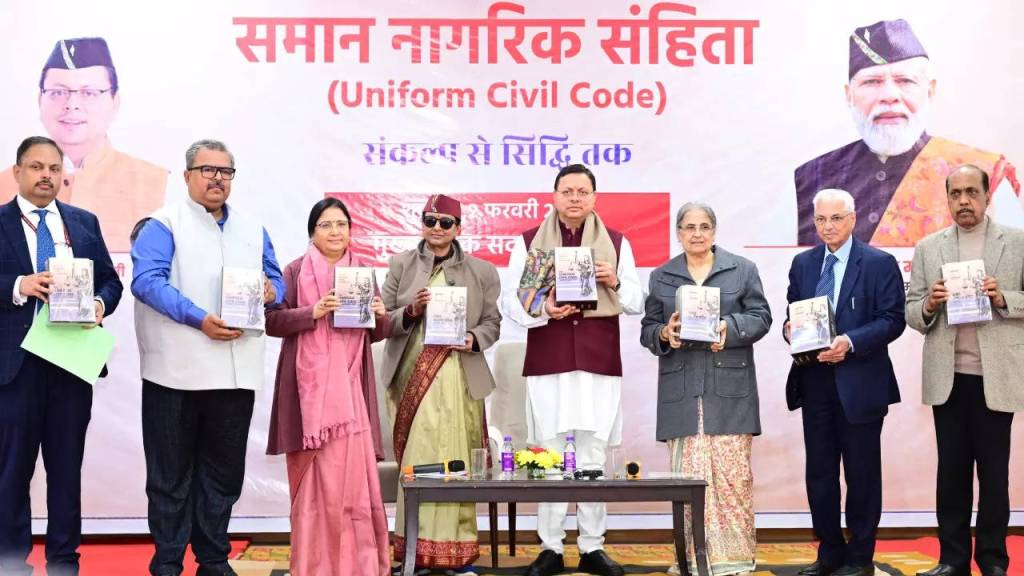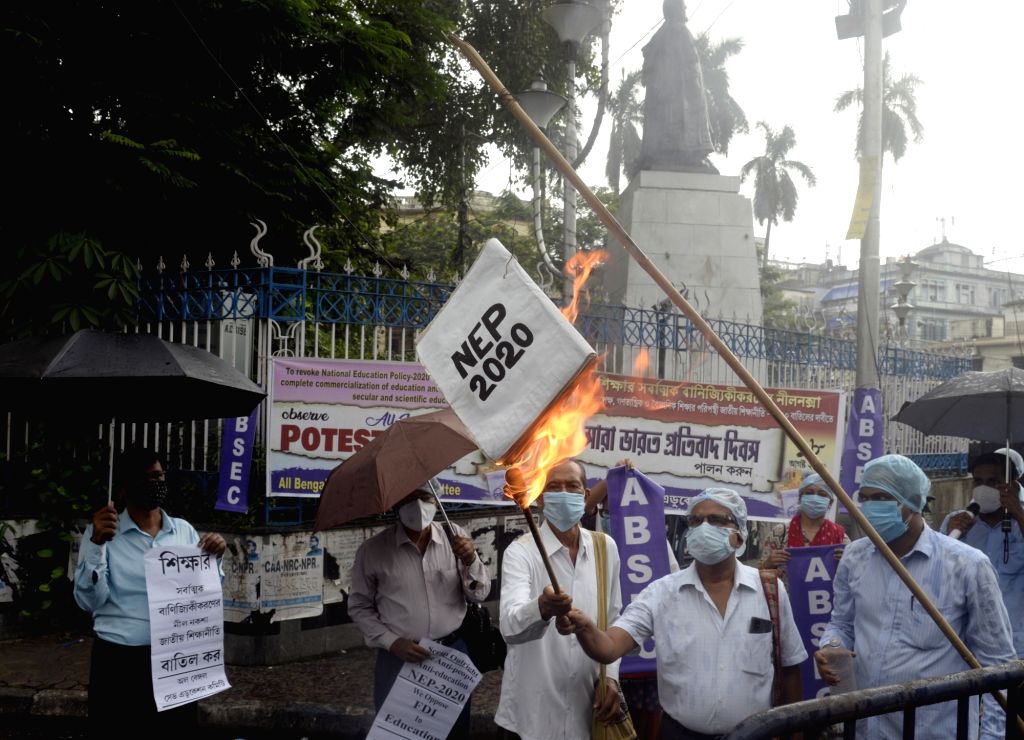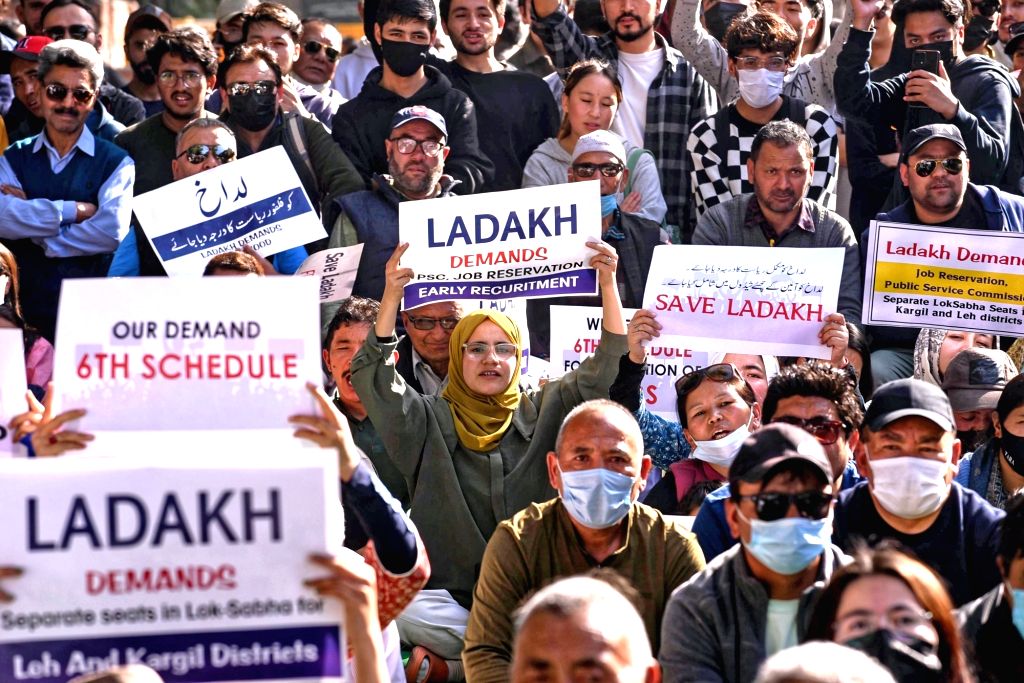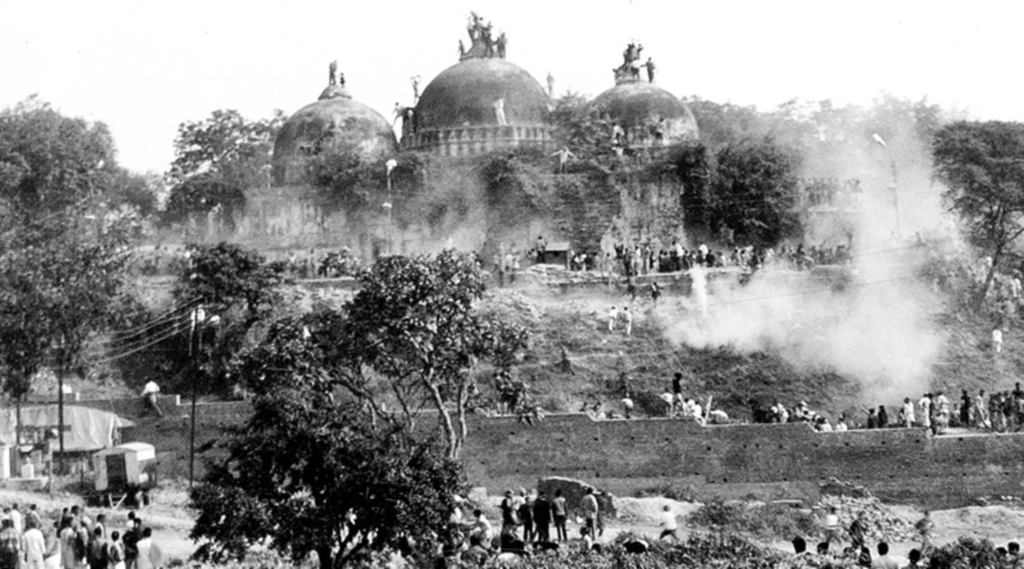On the 7th of February 2024, the Uttarakhand Assembly passed a draft Uniform Civil Code for the state. Since the inception of the BJP in 1980 to the present, a primary agenda of the BJP has been the implementation of the UCC- including it as a point in their election manifesto and propaganda at both the state and central level elections. While the right wing paints it as a “secular” law that will bring about “uniformity”, they also frame the issue in a divisive and anti-minority manner, particularly using it to target Muslim laws and the Muslim community. Moreover, their idea of “uniformity”, as displayed in the Uttarakhand Uniform Civil Code is a Brahmanical Hindu uniformity- Hindu laws regarding inheritance, succession and marriage are reproduced as the new “uniform” code for the whole country, majorly disregarding the various ethnicities, castes, religions, nationalities etc. that constitute India. The right also paints the UCC as a “pro-women” law as they claim it will outlaw regressive religious practices against women legalized by the existing family law framework of the country. The fact is that this aspect is particularly targeted against the minority Muslim community, as in speeches and discourse, it is only the Muslim laws on marriage, divorce and succession painted as feudal and anti- women. Recently, following this trend, the Assam cabinet repealed the Muslim Marriage Act operational in the state, on the pretext of criminalizing child marriage- choosing to invalidate the entire law instead of said provisions allowing for child marriage, and declaring that UCC would be implemented in the state soon.
UCC (Uniform Civil Code) is a legal code that is supposed to overwrite various legal codes in India that are supposedly in contradiction with each other. These laws such as the Hindu Marriage Act, Muslim marriage Act, Hindu Succession Act, Indian Christian Marriage Act etc. are based in colonial era codifications of orientalist conceptions of true scripture and religious law. The UCC claims to solve the contradictions within these laws and bring each Indian citizen under an equal secular law. There has been deep propagation within the democratic progressive sections of the country that UCC can make the law more gender equal. In fact, a huge section of progressive liberals and even the left in the country support the view that a UCC would be the progressive force. While some call out its religious bias, the ruling party’s propaganda regarding the UCC being a progressive law has permeated and gained traction in sections of the petty-bourgeois, intelligentsia, women’s rights activists and other progressive forces.
This article intends to expose the divisive and Brahmanical nature of the UCC, and explore the scope for democratic marriage and succession legislations in current Indian society.
History of Codification of Personal Laws in India
Prior to British colonial law, systems of law and order in the Indian Subcontinent were regional and decentralized. In regions under Mughal rule, Qazis would interpret law for Hindus and Muslims alike, and the documentation in these processes would be used to authenticate the property rights held by people. Familial issues as well as business transactions would be interpreted according to regional and cultural norms. This constituted a legal system with considerable fluidity. However, when the East India company acquired the Diwani rights of Bengal in 1765, the colonial powers started codifying laws to govern the population for the process of revenue collection and legalized resource loot. The company shifted to performing the functions of a state and with it, imposed colonial understandings overwriting various regional practices of law and order.
The codification of criminal and property related laws was of primary importance to the colonizers due to their aims of revenue collection. Warren Hastings, Colebrooke and others provided an orientalist understanding of religious laws. Hastings codified Gentoo (Hindu) laws based on a digest of shastras provided by Pandits. This digest included the Manusmriti and its interpretations on inheritance law. This digest was interpreted by 11 pandits who amplified and codified the Brahminical privileges held by their caste. The casteist Manusmriti was lauded and glorified due to its ancient nature, which orientalists interpreted as pure. The law was treated as homogeneous and subsumed regional and Adivasi practices who were forced to be governed under this limited law. Alongside this due to the assimilationist understanding of Brahmanism, religions such as Sikhism, Jainism and Buddhism were treated as subsidiaries of Hinduism and governed under the same Brahmanical laws. These laws were made the basis of personal laws on marriage, divorce, adoption and succession, carrying forward the same Brahmanical and assimilationist nature forward.
Inherent Bias in the Legal System – An Example
Uniform Civil Code is repackaging Hindu personal law and Hindu morality and imposing it on the population. Despite the claims of decolonisation, this assimilationist exercise furthers the very same colonial process of hegemonizing and suppressing the diverse people of the country. Brahminical Hindutva Fascism uses the UCC as an offensive on oppressed communities in order to snuff out their practices and invisiblise their existence. This is not a new phenomenon, the law in a semi-colonial, semi-feudal state operates as an apparatus for infiltration of imperial capital and maintenance of the status quo that keeps the feudal and comprador nexus in power. The morality that dominates within this class today is a Vaishnavite Brahminical understanding, with the open and state sponsored violence of feudal forces such as gaurakshaks.

We can observe how Brahminical laws affect marginalized communities. For instance, after a demand emerged from the dominant castes in Bihar to protect the “sacred” cow, the state of Bihar introduced a ban on cow slaughter which was challenged by the Qureshi community of Bihar. The Qureshi community are Muslims that depend on butchering as their main means of livelihood and fall under the OBC category. The Qureshis faced a grave threat to their livelihood due to the ban as well as facing violence against their community. Despite several points being made to challenge this ban, which was falsely being purported as environmentally friendly, as well as bringing up the state’s discrimination affecting the Qureshi’s democratic rights to practice their profession and maintain their livelihood which also has a religious basis, their claim was rejected. Whilst a blanket ban on cattle butchering could not be supported after this, the courts also claimed that the ban was not unconstitutional on the basis that other cattle or meats were still available to allow the Qureshis to continue their trade. This case clearly displays how skewed and biased religious morality being applied by the state perpetuates unseen violence and violation of the democratic rights of various communities. This bias is also evident in the Constitution- as seen in the inclusion of banning beef in the DPSP. The state’s bias towards Hindu law displayed in the crafting of the UCC thus makes it pertinent to question, whose morality the state is pushing? And who will become part of their disappearing magic trick?
A Brief Legal History of UCC
The propaganda around UCC has been pervasive and has been slowly unfolding since its initial demand. In 1985, Shah Bano Begum moved the courts to demand her rights to maintenance after divorce. According to Shariat (Muslim) Law, women are only granted maintenance during the period of iddat (89 days or for pregnant women until birth). The law was termed discriminatory and biased against the rights of aggrieved women who would lose any support without maintenance. The Supreme Court interpreted Section 125 of the CrPC to make maintenance absolute for divorced Muslim women. This secular interpretation came with massive upheaval due to its contravention with religious law. The Shah Bano case also led to a demand for a Uniform Civil Code that would further equalize application of laws on Indian citizens and promote gender equality. Many progressive forces rallied behind this idea and presented their own drafts of a UCC taking into account the need for gender-equal and non-discriminatory laws. Within the petty bourgeois intelligentsia and women’s rights groups this version of the UCC was pushed forward as a more democratic law.
The Uttarakhand UCC Draft Bill however exposes the biases in the conception of UCC, and the fears of various sections of UCC being a hegemonic religious law have shown themselves to be very valid and real concerns. Despite multiple drafts of UCC being presented by progressive forces we see the intrinsic faultlines in the application of UCC. The 22nd Law Commission Report on reform in Family Law exposed various faultlines in the conception and application of UCC. Due to the diverse nature of the country any variation of the UCC ends up painting over the cultural practices and understandings of oppressed communities. The exercise of imposing morality onto communities with their own practices also deeply injures the democratic rights and autonomy of various communities. The commission suggested application of a law that would be binding only to individuals that consensually accepted it, alongside developing current personal laws to be more accomodating and equal whilst respecting cultural practices. These suggestions however, have been entirely overlooked in favour of continuous perpetuation of the UCC. False equivalency has also been drawn to Goa UCC which has been drawn up with specific consideration for the conditions, culture and history of the Goan population. Whereas the purview of UCC across a country like India with diversity in regional culture, language, history, multiple nationalities inevitably fails to make these considerations. This method of propaganda, manipulating and omitting context and the realities of UCC is wolf in sheep’s clothing.
We will further analyze the stark realities of the UCC to counter myths surrounding it , laying bare the propaganda being used to mask the sharp blade of UCC turned towards the people.
UCC as Hindu Law
Since the inception of the BJP, a Uniform Civil Code has been a focused part of their election agenda. In the Shah Bano case discussed earlier, the Sangh parivar tooted the paradoxical horn of protectionism and progressiveness, presenting the need for uniform civil laws as a necessary step for the well-being of Muslim women. This was repeated by many progressive sections of Indian society, including women’s rights activists. These sections bought into the representation of Muslim women as oppressed by Muslim men and presented an otherised and villanised picture of Muslim men and Muslim law as inherently more oppressive to women, than Hindu men and Hindu law. This not only presents a factually incorrect picture as per the social reality in India, as according to the National Family Health Survey (2019-21), Hindu and Muslim communities in India have only a marginal difference in the rates of polygamy and child marriage in India. The villanisation of Muslim men as an extraordinary oppressor of women, in contrast to more benevolent Hindu men, is nothing but a poisonous narrative peddled by the Hindutva ruling class of the country to otherise the community in public image, in order to enable their oppression, erasure and exploitation under the Hindutva project. This section intends to elaborate on the nature of the Uniform Civil Code being peddled by the BJP regime and expose its Brahmanical Hindutva nature to all well-meaning progressive sections of Indian society dazed by its secular mask.
The Uttarakhand UCC serves as a good example of exposing the malevolent and Brahmanical nature of UCC in India. On issues of marriage, prohibited degrees of relationships are maintained in accordance with the existent Hindu Marriage Act, ignoring the customary and religious difference for these prohibited degrees under the other religious laws, for Muslims and Christians. While “custom” as under the Hindu law exists as an exception, the legislative requirements to prove the existence of such a custom pose the danger of sending marginalised religions into a new legal battle for recognition of marriage typologies allowed under their personal laws and existent so far. With the biased nature of Indian courts, this is likely to be an uphill battle. No scientific or rational basis is provided for choosing the “Hindu” position on prohibited degrees, the obvious motivation is that of creating a Brahmanical superimposition of a law disguised as secular. Succession and intestate inheritance too is reproduced from the Hindu Succession Act, with a tiny addition of father as under Class I heir. The complex system of succession of uncodified Muslim law, and the differences between Shia and Sunni succession, are utterly negated to favour the Hindu law as the new “uniform”.
This is another portion of the Hindu-Brahmanical assimilation project. Brahminism as an ideology is assimilatory in nature, as explained by Murali, it creates a “graded hierarchy”. As many identities as possible are integrated into the Brahmanical fold but are not given an “equal” status. They fall at some or other degree in the Brahmanical ladder- every subgroup included is given an unequal place where the caste hegemony of the dominant castes is sacrosanct. This assimilatory nature of Brahminism was evident in the codification of Hindu personal laws after the transfer of power in 1947. The ruling class, which was the same Brahmanical class that had historically enjoyed the patronage of the colonial powers and had helped in codifying laws into a singular and new “Hindu” identity, in its parliament passed “Hindu” laws on marriage, divorce, succession and inheritance that included in the definition of ‘Hindu” -Sikhs, Jains, Buddhists and Parsis. The first three religions in this list arose out of a bitter anti-feudal and anti-Brahmanical struggle, they strongly distinguished themselves from the religion based on this Brahmanism and asserted a separate identity. Yet, Indian lawmakers included these religions in the socio-legal fold of “Hinduism”, revealing the Brahmanical aspect of the already existing conception of a Hindu law. The negation of Muslim, Christian and other minority religious/ cultural identity under this law is another extension of the assimilatory aspect of the Brahmanical ruling classes of India.
Peddling Bigotry- Another Cog in the Brahmanical Hindutva Fascist Agenda
The UCC has been smartly packaged as a progressive, pro-women issue, with open anti-Muslim propaganda accompanying its demand. The BJP, which draws its existence from RSS – that strongly opposed the Hindu Code drafted by Ambedkar that modified Hindu personal laws to be less anti-women and Brahmanical, by heralding the importance of personal laws; is today attacking the personal laws of minority communities. From Shah Bano, UCC has been formulated by the ruling BJP as an issue concerning Muslim women. In June 2023, the Prime Minister, Narendra Modi, announced in an election rally an appeal to Muslim women to support the BJP as the UCC is an emancipatory tool for them. But in this polity where the ruling class pedals fascist propaganda and action on oppressed cates, all religious, national, ethnic and gender minorities- the mask of protectionism of Muslim women falls clearly short. With attacks on Muslims all through the country supported by the ruling class, the reality is apparent- clamor over “love jihad”, pompous celebration of a mandir built over the blood of Muslims and Dalits – perpetrated by the very force that is heralding the purported “secular” UCC, and laws like the Citizenship Amendment Act and National Register of Citizens that deny the Muslim community equal citizenships, systematic ghettoisation of Muslims.
The law is an important tool that serves the ruling class in times of increasing fascisisation. In Nazi Germany, laws affecting all aspects of jewish life were first passed- denying them public education, service, right to kosher food , and eventually turning them into second class citizens. This eventually led to a genocide- the Holocaust. The systematic use of the law as a tool of this genocide- the legality of the Holocaust- should be remembered and lessons must be learned from this past. Laws such as the CAA-NRC , UCC ought to be looked at with a similar lens.

The Myth of a Gender just UCC – An Anti- Women, Anti-Queer Law
Certain feminists and progressive sections of the intelligentsia claim the UCC is a progressive law, that it is secular and pro-women. It is important to call the heed of this section towards certain important demands and legal recommendations in Law Commission reports that advocate towards a gender just family law. In the Brahmanical UCC code envisaged under the Hindutva camp none of these just and important changes to the family law have been made. The entire UCC debate is centered around erasing Muslim personal law and replacing it with Hindu personal law, which is patriarchal due to its very Brahmanical nature. The Uttarakhand UCC is demonstrative of this. Restitution of conjugal rights, a colonial era remedy allows for the court to order a husband and wife to stay together in matrimonial unity even if one of them expresses the will not to live with the spouse. In the Indian socio-legal conditions, where patriarchy permeates the structure of all relationships, particularly marriage, and marital rape is not illegal- this amounts to providing a legal situation where a wife is forced to face rape by her husband. This regressive provision retains itself in the Uttarakhand UCC. Irretrievable breakdown of marriage as a reason for divorce is not recognised – although it has been a long-term demand in the space of democratizing family laws, since it gives space for unhappy and unworkable marriages to end when the couple has, for a long time, been unable to resolve the issue or reach a compromise. The father is retained as the sole legal guardian of the child, with the mother’s role restricted as a caretaker, as in the Hindu law, under the Uttarakhand UCC. These are all patriarchal aspects of the existent family law that earlier suggested drafts of UCC, framed away from Sangh influence, had included. The current model envisages none of these amendments.
An aspect of the Uttarakhand UCC that has been heralded as progressive is the recognition of live-in relationships. The new laws regarding live-in are now codified in the state, and the rights of recognition, guardianship, maintenance and legitimacy of children granted had already been existent as per the Supreme Court judgements. The one new and unique aspect of this live-in provision is compulsory registration of a live-in relationship within one month of entering into such a relationship. In a state and a house of ministers that believe in the “love jihad” conspiracy, in a legal system where compulsory public notice of marriage under the Special Marriage Act has led to many honor killings over interfaith and inter caste marriages, in a society where caste affects every aspect of a person’s life- this provision can have but one effect, promoting regulation of non-marital interfaith and inter-caste relationships by a bigoted state. This is something to be deeply concerned about as given the hatred and religious zeal prevalent over interfaith and inter caste unions and the state’s role in engineering crimes involving such couples- a possible result of this is more state-engineered hate crimes. This, then, isn’t a progressive provision, but one that unleashes violence on consenting couples. The fact that feminists and other “progressives” are lauding this reeks of poor analysis and a social lens that views themselves to be unaffected by this aspect of the provision. The lauding of this law comes from their class position- as socially well situated individuals, the persons making this analysis refuse to recognise the poisonous effects of this law.
Other progressive demands for change in family law in India have included a demand for laws providing equal rights to queer couples, and the struggle for traditional gender identities like hijras, khwaji khoras etc. to get dignity, respect and recognition in marriage, adoption and succession laws. The invisibilization of the hijra community within the country continues, facing again a threat to their practices and a removal from their cultural roles in society through the imposition of Brahmanical culture and customs. They also remain absent from the sections of inheritance and adoption, the code ignores their existence and demands in perpetuity seen in the deeply tone deaf and disconnected Transgender Persons Bill 2019 and the demands for horizontal reservation falling on deaf ears. Due to the feudal nature of the Hindu law forming the basis of UCC- such changes cannot be envisaged under it , it can only be expected to worsen and continue state surveillance and active oppression of oppressed gender communities.
CPM’S Anti-Marxist stance on the UCC
The revisionist Marxist parties in India have historically backed the UCC. EMS Nampoodiripadu, the first chief minister of Keralam and CPM intellectual, has backed the UCC. Their stance is that when a ‘secular’ party passes the UCC they will back it up but a communal party like BJP will impose Hindu laws across the country. This is a non-Marxist approach. The fact is that the Indian ruling classes have always been Brahminical, earlier the ruling class had an implicit and soft Brahmanism and now it’s violent and explicit. This is the only difference that has happened to the ruling class ideology. This Brahmanical ideology exists as the guiding light of the ruling class due to the fact that the ruling class in India are the comprador bureaucratic bourgeois and landlord sections that have arisen from the semi-feudal conditions of India. Therefore, it’s obvious that their ideology will also be feudal Brahmanical. The support that all the ruling class parties including the ‘secular’ parties have towards the Pran Prathishta ceremony, and the soft Hindutva of Indira Gandhi is a case in point. Even CPM and other revisionist parties gain from the Brahmanism of the ruling class. This is exactly why CPM has a soft-handed approach towards RSS, which tries to create riots within the state and a brutal approach towards innocent Muslims. PFI which stands for anti-fascism had cadres arrested under UAPA under the CPM led Kerala government, while RSS people who have killed Muslims were allowed to walk freely. VS Achuthanandan- the ex-chief minister of Keralam, who was from CPM, has backed the Love Jihad theory that was propagated by RSS. The anti-Muslim stance that they take is because of the Brahmanism of the Indian society. Unless this Brahmanism is removed, no true secular laws can be imposed in this country.
UCC as an attack on Adivasis and Nationalities
The state’s tireless offensive on Adivasis and nationality struggles is abundantly clear in the history of militarisation and corporate loot it supports. Bombings in Central India and Kashmir respectively are testaments to the war of the country against its own people. There have been continuous attempts at land grabbing and loot of Adivasi resources through propaganda and “re-education”. The dreams of development being peddled by the State are far divorced from the material conditions and needs of the Adivasis. These “dreams” imposed on the people are being manufactured by terming the Adivasis and their cultural practices as “savage” and “backward”. Repackaging the same prodding, dehumanizing ideas that lead to the development of anthropology, the colonizers’ study of tribes.
This colonial process continues to this day though the agents of imperialism. In India, we see attempts at reeducating Adivasis through projects like KISS (Kalinga Institute of Social Sciences) that attempt to alienate Adivasis from their culture and “civilise” them. Adivasi children are molded according to the whims of Hindutva Brahminical Fascism, with many feeling shame over their identities. KISS also collaborates with corporates like Tata and Vedanta that loot the resources of Adivasis and displace them. The fealties of these projects are abundantly clear in their brainwashing of children to allow easier infiltration of imperialist capital. The children face saffronisation and hinduisation, being taught to accept Hindu practices as well as facing Hindu feudal morality around gender separating co-ed spaces, antithetical to the communal practices of their communities.
The UCC with its assimilationist nature poses a severe threat to Adivasis already facing an encircling onslaught from the State. Adivasis will be forced to follow Hindu customs of marriage, inheritance and succession. The burden of proof to recognise customs is already extremely high but with the application of UCC, many tribes face a magnified threat to their ways of life. For instance, many tribes have patrilineal inheritance, the aims of gender equality here are limited in their scope due to a lack of analysis of Adivasi culture. Change in inheritance laws has been linked to a fear of land grabbing from people outside the community through practices like forced marriage. The communal ownership of Adivasi land is also overwritten by a private ownership model by the UCC. These laws do not exist in a vacuum and the application of Brahmanical laws such as UCC on oppressed communities comes with the dangers of disturbing livelihood and established practices based in harmony with their material conditions. This implementation thus also furthers the campaign of assimilationist reeducation of Adivasis. We also see a similar pattern with nationality struggles, with the saccharine zeal that erupted with the abrogation of section 370 which removed protection of Kashmiris and brought them under central control. This abrogation is an attack on the nationality struggle within Kashmir. Similarly in Leh the demand for being included within the 6th schedule is also tied with a struggle for nationality and self determination. This struggle is also being clamped down upon. An all-India UCC, will also clamp down on cultural, regional and national identities within India.
Conclusion
It is clear that the UCC is a Brahmanical imposition aimed at further suppressing, disenfranchising and erasing the identities of minority religious communities, oppressed castes, nationalities and adivasis with distinct customs, and contrary to the picture painted by pro-UCC propaganda, it is not a step towards gender justice. It is a tool for electoral propaganda, but also much more- a step towards erasure of all other identities in the assimilatory yet exclusionary fascist project of Brahmanical Hindutva. The UCC exists as a Brahminical farce wherein like the pandits interpreting shastras for codification, the comprador bureaucracy twists the laws to favor and maintain their position in the status quo. This raises the question- would a “uniform” personal law be desirable under a parliamentary force that is not the BJP? Or is the demand for reform in family law incomplete by a restrictive characterisation of a Uniform Civil Code?
India is a semi-colonial, semi-feudal country, where the tentacles of feudalism merge with the penetrative grasp of imperialist capital to unleash brutal and incessant exploitation and oppression on the broad masses of the country, including the proletariat, the peasantry, oppressed castes, religions and gender identities, petty bourgeois, national bourgeois. The feudal grasp on our country and the imperialist loot reflects in the insufficiency of laws made by a parliament (regardless of which party sits at the fore)- as evident in the prevalence of polygamy, child marriage etc. despite clear laws to the contrary. Our family courts themselves reflect this feudal structure- with restitution of conjugal rights being a remedy, and there being cases where not wearing a mangalsutra, not serving in-laws chai or having a pimple by a woman have been granted as legitimate grounds for divorce by judges. At the same time, it is highly difficult for persons oppressed under this structure of feudal marriage, to seek a legal redress to cruelty, or to leave the shackles of such a marriage- because despite legal provisions being available, the courts will redress it according to their own morality.
The law, made by a ruling class that is inherently an agent of the landlord and comprador capitalist class, will never be a sufficient tool for emancipation from oppressive personal law realities. Any democratisation of family laws, to transform into a social reality, must be accompanied by a change in the material structures of the society- it must be a cultural change that transforms the consciousness of the people. But firstly, a struggle for revolutionary change of the systems of oppression and exploitation that makes any democratisation through law surface level, and a social reality only for the more privileged classes, is a necessary prerequisite. The struggle against fascist laws like the UCC is a part of this broader democratisation of society, and all forces such as women, oppressed castes, minority religious communities, and the progressive intelligentsia, must present a united struggle against this Brahmanical Hindutva imposition.
By Ramnit Kaur and Aditi Kumar, students of law at Jindal Global Law School
Citations
- https://thewire.in/rights/what-the-proposed-uniform-civil-code-should-not-be\
- Uniform Civil Code of Uttarakhand, 2024
- https://thewire.in/women/a-hindutva-model-of-uniform-civil-code-may-make-it-even-worse-for-women
- https://www.msn.com/en-in/news/India/understanding-the-provisions-and-legal-context-of-the-ucc-bill/ar-BB1hSG16
- https://www.msn.com/en-in/news/other/what-will-change-after-repeal-of-assam-muslim-marriage-divorce-registration-law/ar-BB1iNqOF
- https://doi.org/10.23943/princeton/9780691174433.003.0004
- https://www.google.com/url?sa=t&source=web&rct=j&opi=89978449&url=https://caravanmagazine.in/education/kiss-kalinga-tribes-adivasi-anthropology-world-congress&ved=2ahUKEwj_hemaxreFAxXizjgGHWmOADQQFnoECDwQAQ&usg=AOvVaw1jdN2h_iOLoJyZdJ99Zw4f
- https://thewire.in/education/india-factory-school-model-like-kiss






Leave a comment